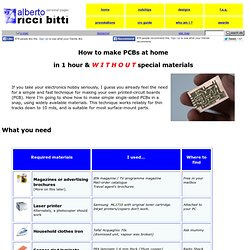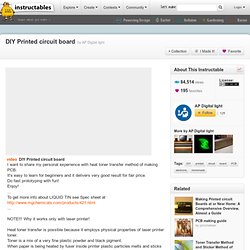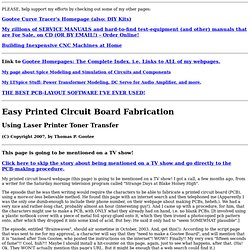

Make PCBs at home with magazine paper and your laser printer. How to make PCBs at home in 1 hour & W I T H O U T special materials What you need You need also: a blade cutter, scotch tape, sandpaper, kitchen paper, cotton wool, vice, hacksaw.

How it works Laser printers and photocopiers use plastic toner, not ink, to draw images. Finding the right paper The perfect paper should be: glossy, thin, and cheap. Paper preparation I discard pages heavily printed, preferring pages with normal-size text on white background. Printer setup Laser printers are not designed for handling thin, cheap paper, so we must help them feeding the sheets manually instead of using the paper tray. Printing Disclaimer: your laser printer is not designed to handle this kind of paper. This is my PC thermometer circuit printed on IEN magazine paper. How to cut raw material PCB material is fibreglass like, and a trick to cut it effortlessly is to score a groove with a blade cutter or a glass cutter. Cleaning the board for transfer Preparing for transfer Iron it! Peeling The hanger tool . Making PCBs. How to make really really good homemade PCBs Note - this article is original material.

There is currently a plagiarised copy of it on the site of an Indian electronics magazine credited to a rip-off artist called Indrani Bose. This page is a guide to producing consistently high quality PCBs quickly and efficiently, particularly for professional prototyping of production boards. Unlike most other PCB homebrew guides, emphasis is placed on quality, speed and repeatability rather than minimum materials cost, although the time saved by getting good PCBs every time usually saves money in the long run - even for the hobbyist, the cost of ruined PCB laminates can soon mount up!
With the methods described, you can produce repeatably good single and double-sided PCBs for through-hole and surface mount designs with track densities of 40-50 tracks per inch and 0.5mm SMD pitches. Artwork generation When defining pad and line shapes, the following minimum sizes are recommended for reliable results: Media. DIY Printed circuit board. I want to share my personal experience with heat toner transfer method of making PCB.

It's easy to learn for beginners and it delivers very good result for fair price. Do fast prototyping with fun! Enjoy! ... To get more info about LIQUID TIN see Spec sheet ... NOTE!!! Heat toner transfer is possible because it employs physical properties of laser printer toner. If you don't have laser printer you can use xerox to make copy of your artwork. Easy PCB (Printed Circuit Board) Fabrication, Using Laser Printer Toner Transfer, with a Household Clothes Iron and Glossy Inkjet Photo Paper; DIY at Home; Better AND Cheaper than Press-n-Peel ( PnP / P-n-P )! Making, Cheap , Economical , fastest fast tur. PLEASE, help support my efforts by checking out some of my other pages: Gootee Curve Tracer's Homepage (also: DIY Kits) My zillions of SERVICE MANUALS and hard-to-find test-equipment (and other) manuals that are For Sale, on CD (OR BY EMAIL!)

- Order Online! Building Inexpensive CNC Machines at Home Link to Gootee Homepages: The Complete Index. i.e. My page about Spice Modeling and Simulation of Circuits and Components My LTSpice Stuff: Power Transformer Modeling, DC Servo for Audio Amplifier, and more. Using Laser Printer Toner Transfer (C) Copyright 2007, by Thomas P. This page is going to be mentioned on a TV show!
Click here to skip the story about being mentioned on a TV show and go directly to the PCB-making procedure. My printed circuit board webpage (this page) is going to be mentioned on a TV show! The episode that he was then writing would require the characters to be able to fabricate a printed circuit board (PCB), using a more-or-less believable method.
It was ON! HA! Everyone, - Tom.